ASUS Zenbook Prime (UX21A) Review: The First of the 2nd Gen Ultrabooks
by Anand Lal Shimpi on May 22, 2012 2:46 PM EST- Posted in
- Laptops
- CPUs
- Asus
- Ivy Bridge
- Zenbook
- Zenbook Prime
- Ultrabook
- Notebooks
The Zenbook Prime Exterior
The all-aluminum Zenbook chassis makes another appearance with the Zenbook Prime. It's the same thickness and weight as its predecessor. The Prime also features the same port configuration. On the 11-inch model you get two USB 3.0 ports (one on each side), a mini VGA out (with bundled dongle), micro HDMI out and shared audio/mic jack. The 13-inch model adds an SD card reader, while the thicker UX32 adds full sized HDMI and a third USB 3.0 port on top of that.
While the outside of the Zenbook hasn't changed at all, it's what's inside that's completely different. Both the UX21 and UX31 now feature 1920 x 1080 IPS panels. I'll get into the debate over the usability of such a high res on such an 11.6 inch display shortly, but at a high level this is just awesome. ASUS is finally putting the type of attention we've been asking for on display technology. The 1080p panel on the UX21 looks amazing and performs extremely well as you'll soon see. I can only assume the UX31's panel is similarly impressive.
What else got updates? The camera (now 720p), keyboard, trackpad, WiFi, USB 3.0 and power adapter, to name a few.
The New Keyboard
The keyboard is all-new on the Zenbook Prime. Although it doesn't look as stylish as what ASUS introduced in the original, the new keyboard is worlds better to type on. It feels almost identical (but not completely) to the MacBook Air keyboard, which in my opinion is a good thing. Finger fatigue is significantly reduced compared to the original Zenbook. ASUS claims 12% increased key travel compared to the predecessor which definitely contributes to a better typing feel.
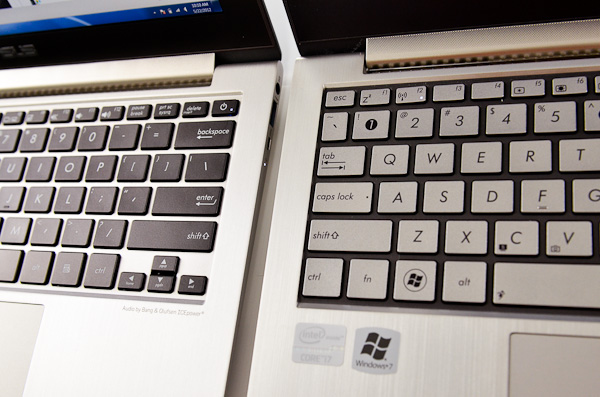
The new keyboard (left) vs. the old keyboard (right)
The keyboard obviously looks very similar to Apple's chiclet as well and now features a LED backlight. There are three selectable brightness settings for the keyboard backlight (four if you count off), which you control via a keyboard shortcut (fn F3/F4).
A Much Improved Trackpad
The problematic trackpad from the original Zenbook was actually addressed mid-cycle last generation. ASUS switched to an ELAN trackpad that did away with most of the issues I encountered. Users who wanted the new trackpad could call, complain and should've been able to get their unit swapped out although there was never a formal replacement program. The Zenbook Prime uses the same trackpad, although this is my first personal experience with it in a Zenbook.
In short, it's much better than what I originally reviewed. Keeping one finger on the trackpad's left click area while you move the pointer is no longer an issue. The pointer will occasionally refuse to move but it's very rare and ASUS even ships software that lets you tweak the trackpad's sensor to better match how you use it:
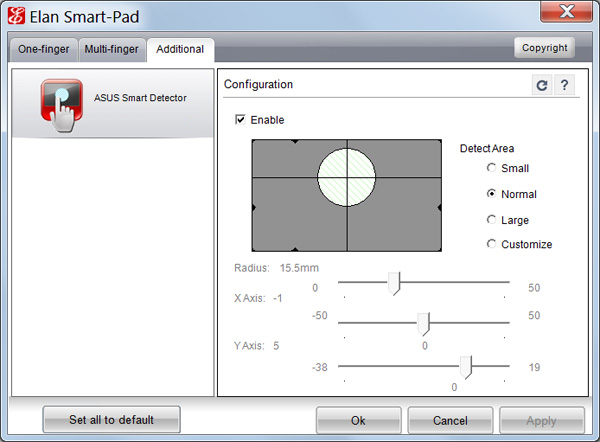
Tap to click and actually clicking the trackpad are both non-issues again. Two finger scrolling as well as three finger forward/back gestures all work very well. Overall the experience is pretty good, albeit not quite perfect. It's likely the best ASUS can do without writing its own trackpad driver. At some point it may just come to that however.
An Updated Power Adapter
The 45W power adapter from the Zenbook gets a slight update as well. Remember the charge indicator that never turned off? Fixed. Also the somewhat worrisome power connector has been beefed up, it's a bit thicker and I'm less worried about it snapping off.
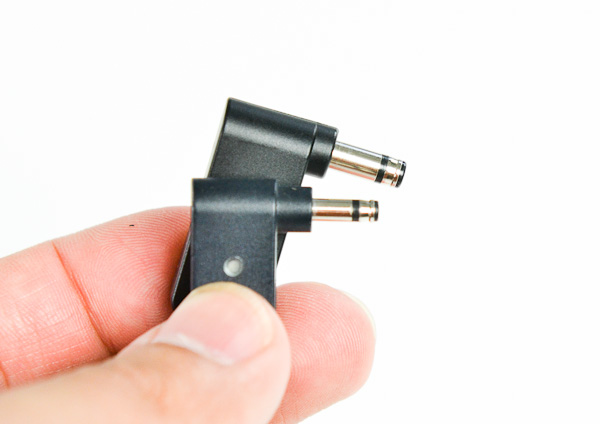
The old Zenbook power connector (bottom) vs. the new Zenbook Prime connector (top)
I shouldn't be surprised that ASUS fixed these things but it's just so rare that a company listens to feedback and acts appropriately in such a short period of time. I would still like to see a MagSafe clone and better cable management than a bit of velcro, although navigating around any associated patents there should be fun for ASUS' lawyers.
Vastly Improved WiFi
The original Zenbook featured a 2.4GHz Qualcomm Atheros AR9485 802.11b/g/n WiFi solution. Only supporting a single spatial stream the best sustained speeds I saw were around 5MB/s using 20MHz channels at 2.4GHz. The Zenbook Prime offers a considerable upgrade.

Now inside the machine is Intel's Centrino Advanced-N 6205 controller. The 802.11a/g/n controller adds 5GHz support and link speeds of up to 300Mbps. In practice I saw a doubling of performance under the same conditions as the original Zenbook (80Mbps vs. ~40Mbps).
As a side benefit, since ASUS is using Intel's Centrino WiFi on an Intel platform it also by default supports Intel's Wireless Display (WiDi) technology.
Just like last time, the UX21A comes with a sleeve case, VGA dongle and USB to 10/100 Ethernet adapter.
USB 3.0 on Both Ports
Courtesy of Intel's HM76 chipset found on the Zenbook Prime's motherboard are the notebook's two USB 3.0 ports. The original Zenbook had a single USB 3.0 port and one USB 2.0 port by comparison. USB 3.0 performance is a bit higher than what I measured with the original Zenbook. I had no problems sustaining transfers at above 170MB/s.
VGA and HDMI out are also supported. There's no Thunderbolt or DisplayPort on the Zenbook Prime unfortunately.
Simplified SSDs
The original Zenbook offered one of two SSDs depending on the model you picked up: Sandisk's U100 or ADATA's SandForce SF-2281 based XM11. If you'll remember back to my review of the original Zenbook I expressed concern that ASUS was shipping a known buggy firmware with the ADATA drive, although admittedly I didn't run into any of the SandForce BSOD issues during my review of the system. It looks like those concerns can be put to rest as ASUS has dropped SandForce from the Zenbook Prime. Sandisk's U100 is all that's available now.
As we've alluded to in the past, the U100 isn't the fastest SSD on the block but it should be very well priced for ASUS and obviously faster than a mechanical drive. Read speeds are quite good, but write performance is where the U100 falls short. Do a lot of IO (e.g. install a game or just write sequentially to the drive) and you'll notice IO latencies increase. It's the same issue we ran into early on in the MLC client SSD space, but no where near as bad. The good news is there's no stuttering or other similarly undesirable behavior. The system still functions like it has an SSD, it's just that it could be a lot faster under load. I'm saving a full investigation into U100 performance for final Zenbook Prime hardware.
My hope is that we'll see vendors offer drop in replacements for the drive similar to what we saw OWC do for the MacBook Air. I still haven't gotten a straight answer as to whether or not the ASUS drive is electrically compatible with the MacBook Air SSD, nor have I been brave enough to risk nuking a drive to find out. Update: the two SSDs are physically similar, but not physically compatible. Here's a challenge to all SSD makers out there: build an upgrade kit for the Zenbook.


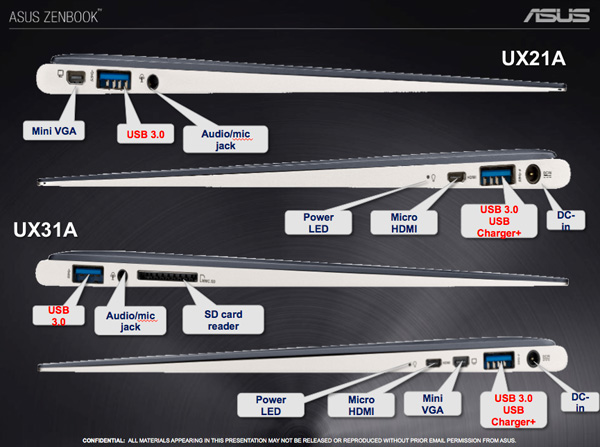
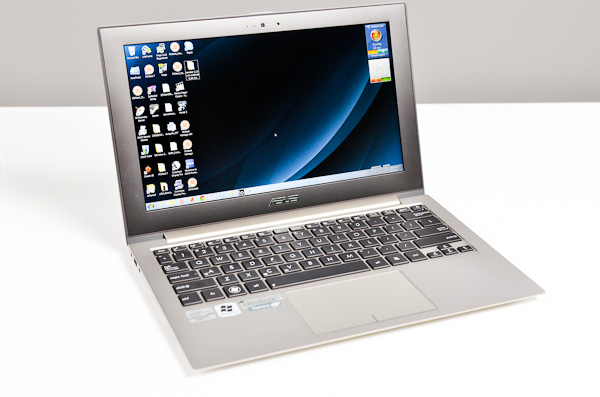






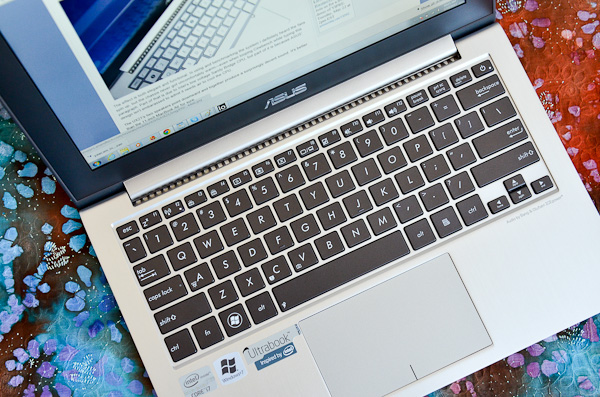
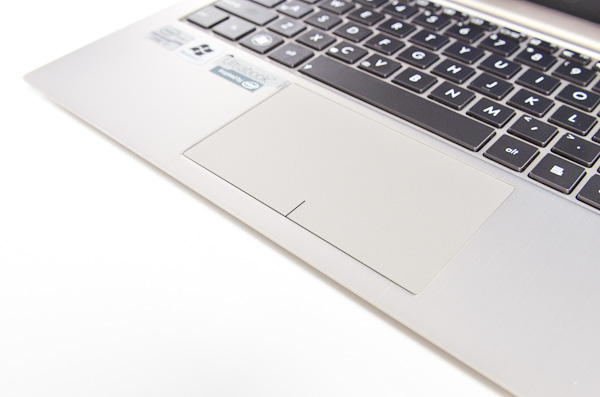
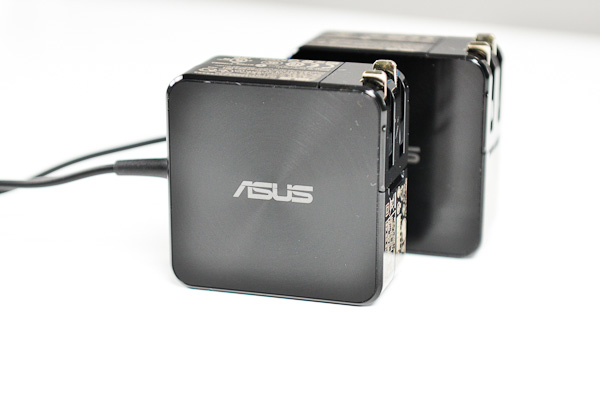
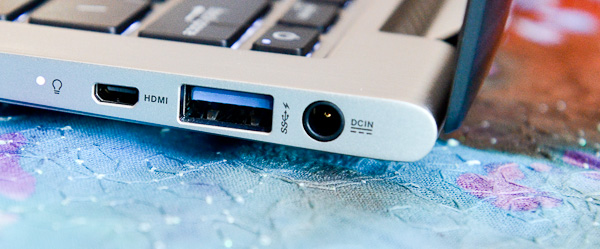








192 Comments
View All Comments
JarredWalton - Wednesday, May 23, 2012 - link
Possibly, though it's NVIDIA hardware and I think GT 620M is just recycled GT 525M or something (Fermi GF108), so it can't do all three. However, it might be able to do internal on the IGP and two external on discrete? Somehow I doubt it, though; the only laptops I've ever seen running more than two simultaneous panels are using AMD GPUs.rosege - Thursday, May 24, 2012 - link
not sure how you count your panels but I have 2 external displays plus the laptop display running on an old X301using a usb to dvi connector for the second external display - you couldnt use it for anything too serious but for general office apps its fine
Penti - Thursday, May 24, 2012 - link
Dell XPS 13 with Ivy Bridge? HP Elitebooks (Elitebook Folio?) with Ivy Bridge? Report back sometime :)We won't find out until later in June I guess.
amalinov - Wednesday, May 23, 2012 - link
Actually there is a way to have what 1ceTr0n wants and keep the ultrasleek design:- fully implemented (micro-)HDMI - that includes CEC and Ethernet, which are optional in the HDMI spec (for CEC you need to add a very small chip - until Intel/AMD/Nvidia start implementing CEC in the GPUs; for Ethernet you need your standard laptop Ethernet controller - Intel, Broadcom or whatever; then you need only a cheep passive cable to use Ethernet)
If I were in ASUS place I would have done also the following about ports:
- fully implemented mini-DisplayPort (instead of the mini-VGA) - that includes CEC and USB2.0 (for CEC you need to add a very small chip - until Intel/AMD/Nvidia start implementing CEC in the GPUs; for USB - just redirect wires from the chipset; USB in Displayport comes in handy for single cable to monitors with integrated USB hubs/cameras, also it can be converted to one additional standard USB port by the use of cheap passive cable - for devices tolerating 3.3V or having their own power supply - such as hubs) - and Thunderbolt as option for 13" premium models
- USB3.0/eSATAp600 combo ports (for the forum skeptics - http://www.delock.de/produkte/F_246_intern_61862/m... is an example of such port) supporting USB Battery Charging 1.2 (7.5W over standard cable) and draft USB Power Delivery (100W over new type of cable) - and remove the power input port (the laptop will be charged by one of the USB PD ports - just like phones are charged by micro-USB currently) - more space for SD card reader or other ports/LEDs/wireless switches
Wireless interfaces I would've added:
- Bluetooth 4.0+HS (over WiFi PHY)+LE (over WiBree PHY)
- NFC
- FM radio with RDS and internal antenna - receiver and transmitter
Options for premium models:
- GPS/GLONASS/Augumentation satellites support; accelerometers, gyroscopes, magnetometer, altimeter - for inertial navigation indoors and other locations with weak satellite signal
- 2G/3G/LTE
- DVB-T/T2/H/SH (or equivalent US TV broadcasts) tuner with internal antenna
Premium models power adapter with:
- additional USB3.0 BatteryCharging/PowerDelivery ports (when the laptop is disconnected those will only provide power to other USB-powered devices; when the laptop-or-another-USB-host is connected a USB3.0 hub in the power adapter will provide also USB connectivity to the connected devices (like a docking station); switch to choose whether the power adapter USB ports should remain powered when no USB host is connected
- maybe integrate the bundled USB-to-Ethernet converter here (but this is kind of redundant if the HDMI port is of the Ethernet-enabled variety)
- maybe also add a USB audio controler providing 6 jack analog jacks (for 7.1 output, line-in, microphone)
Other additions (some of which not very realistic for the time being):
- Anti-glare matte display (if it isn't already of this type)
- Fanless design (if it isn't already of this type)
- Multi-touch screen with support for 10 fingers+2 palm-restings and maybe stylos/handwriting
- Touchpad occupying the whole surface below the keyboard with support for 10 fingers+2 palm-restings and stylos/handwriting; maybe even a second screen (for customizable buttons, auxiliary information like level map, etc.)
- two multi-megapixel back cameras with autofocus, xenon flash, night-mode video illumination, etc. (just like high end phone) for stereoscopic pictures and 2x1080p60 (3D) video
- two 1080p60 front cameras (for 3D mode) - either with separate illumination or utilizing the keyboard illumination
- integrated Kinect-like gesture recognition system with sensors and array microphones
- two picoprojectors on the back (for 3D mode)
Let's hope the above gets implemented in the Haswell (or AMD 28nm) Zenbooks. However, those are not deal breakers (but especially the port section is cheap to do, so kind of expected), so I congratulate ASUS for the Zenbook Prime!
krash3x - Thursday, May 24, 2012 - link
I can see that its kinda pointless to have an ether net port on an ultra portable device but I can also say that sometimes its good to have one. Like trouble shooting connection issues making sure its not something interfering with your wifi or if you want to reduce latency. I have a quick question, how does the display compare to the screen on the new ipad? I'm looking to get something to replace my asus 1201n, and I'm kinda interested in this thing. although it would be nice if it had a dedicated gpu :-/rosege - Thursday, May 24, 2012 - link
this model has dedicated gpuUX32VD-DB71
mcquade181 - Tuesday, May 22, 2012 - link
I agree.The lack of a gigabit ethernet port is a killer. It means copying videos etc from you desktop computer to this will take 10 times as long.
mackintire - Wednesday, May 23, 2012 - link
a gigabit to USB 3.0 adapter will work fine. USB 3.0 is quite a bit faster than gigabit ethernet. Currently we have a DELL XPS13 package for our users that includes the USB 3.0 to gigabit ethernet adapter, they appear to run at full speed transferring 100MB/s with no issues.Sunburn74 - Thursday, May 24, 2012 - link
Thank you for making sense, unlike all these complainers. Most of the additional connectors a person specially needs can be found in the form of adapters and port expanders.Penti - Thursday, May 24, 2012 - link
A Gigabit ethernet adapters as it should also speeds up for USB 2.0 users quite a bit. Easily beets 100Mbit/s any how. Won't do near 1 Gigabit/s however. But it should work as fast as your basic home-user NAS. If you need more you probably has direct attached storage or even fibrelink so :) Nice to see USB 3.0 get native, and yes it's fast enough for most users and are capable to extend things like Ethernet, basic storage.